Research Summary. B2B, or business-to-business, transactions are a crucial part of what keeps the market going. After all, you wouldn’t be able to buy your favorite holiday candle if the candlemaker couldn’t buy wholesale wax. Especially considering the challenges of the COVID-19 pandemic, reliable B2B is more important than ever. But, what is the true status of B2B in the U.S.? According to our extensive research:
-
B2B e-commerce revenue in the U.S. reached $6.7 trillion in 2021.
-
Nurtured B2B leads generate 47% larger purchases than non-nurtured leads at a 33% lower cost.
-
59% of B2B marketers believe that email is the most effective marketing channel.
-
At least 68% of B2B businesses have not identified their sales funnel.
-
A considerable 68% of B2B customers are lost due to perceived indifference or apathy.
-
Advertising spending for U.S. B2B companies amounted to $8.68 billion in 2020.
For further analysis, we broke down the data in the following ways:
Sales | Buyers | Companies | Digital Marketing | Trends + Projections

B2B Marketing Strategy Statistics
Considering the sheer size of the B2B market, B2B companies need to have a strategic market plan. There are plenty of market strategies, with some being more effective than others. Here are the facts:
-
The conversion rate for cold calls is around 2%, while the conversion rate for cold emails is around 1%.
Which means neither is an extremely effective tool on its own. Instead, lead nurturing emails and calls are far more effective, with the possibility of increasing conversion rate by 70%.
-
Today, 68% of B2B businesses plan to increase their investment in video marketing.
This isn’t a surprise, given that 83% of marketers believe video content is more important now than it ever has been. Plus, another 80% of marketers say they’ve noticed an uptick in sales after adding video content.
-
59% of B2B marketers believe that email is the most effective marketing channel.
And this value can be seen clearly by the fact that email has an ROI of $42 for every dollar spent. That means you can make x40 your investment in returns simply by using email.
-
83% of B2B marketers make use of social media content.
With 51% of marketers reporting that social media resulted in lead generation and sales growth in 2020. Going forward, the importance of social media sites like LinkedIn is only expected to grow.
-
76% of B2B companies utilize blogs as a considerable portion of their content marketing strategy.
This seems to be working, as blogs can help generate up to 67% more leads per month. Blogs are a great way to give customers more information about your business, and 86% of customers agree that they would be more likely to engage if they received more insights.
-
56% of CMOs are focused on improving customer experience in the next 2 years.
Other major areas of focus include rolling out brand new go-to-market straetgies and introducing major shifts in how the organization generates revenue.
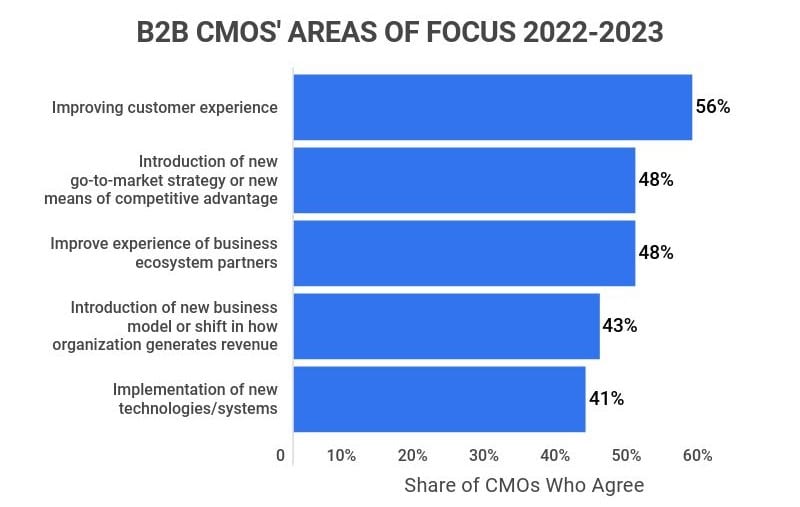
B2B Statistics by Sales
Of course, no B2B business is successful without sales. And, with the amount of competition out there, it takes skill to draw in customers. When it comes to B2B sales, here are the insights our research uncovered:
-
B2B buyers are usually 57% of the way toward a decision before engaging with sales teams.
This means that it’s becoming more and more crucial to pull customers in before they even reach the “buying window.” For instance, B2B businesses can benefit from an outreach that identifies a buyer’s business problem and then focuses on developing a vision for solving that problem.
This can give the buyer a positive view of the business before they even engage with sales teams.
-
45.6% of B2B buyers want to hear new ideas at the start of a sales conversation.
This means that buyers are craving personalization and market specialists that will offer that to them. With that in mind, the more a B2B business can advertise unique solutions and cater to their customer base’s interests, the more successful that business will become.
-
A considerable 82% of B2B buyers think sales representatives are underprepared.
Broken down into more detail, the top three reasons why B2B buyers feel this way is because:
78% were unhappy with the complete lack of case studies, or examples sales reps could share with them, 77% don’t believe sales reps understand their issues or how the B2B’s products could solve them, and 75% say that reps didn’t come prepared with knowledge of their business.
-
Lead generation is a top measure of success for 85% of B2B marketers.
However, lead generation and conversion are easier said than done, with only 6% of B2B businesses believing their team’s efforts are “highly effective.” Most agree that a decent conversion rate for B2B businesses is between 2%-5%, while the average B2B business has a rate of less than 2%.
B2B Statistics by Buyers
Attracting buyers from other businesses is what B2B is all about, but sometimes that’s easier said than done. Luckily, while every buyer does have their quirks, there are valuable trends a majority of buyers will follow. Here are the facts:
-
55% of B2B buyers search for information on social media.
A further 72% actively use social media to find what they are looking for. That means that B2B businesses that invest more into social media will likely see positive results.
-
As of 2021, 67% of the buyer’s B2B journey is done digitally.
Likely, this growing number is due to the fact that a majority of B2B discovery comes from direct vendor websites, internet searches, social media, and email.
-
63% of customers need to hear a company’s claim three to five times to believe it.
That means most buyers go into the sales process with very little confidence in a company’s brand. This is part of why factual information shown in videos, blogs, and other mediums is so valuable.
-
Customer referrals account for 54% of all B2B leads.
Making customer referrals far better than any other method of lead generation by a landslide. The only other major methods of generating leads are through email or direct marketing (14%), the internet (8%), and events (7%).
-
The number #1 selling point for B2B buyers is insightful content, with 51% relying on content for pre-purchase research.
In fact, buyers are 5x more likely to engage with a sales rep who imparts new insights about their business, meaning that educating customers is more likely to provide sales than aggressive marketing.
-
A massive 90% of B2B buyers don’t go down a linear sales funnel path.
Which means marketing is complicated. Luckily, one of the best ways to get around this is through SEO, as it will help these buyers find your B2B business. And, when done right, you’ll also generate brand or campaign awareness.
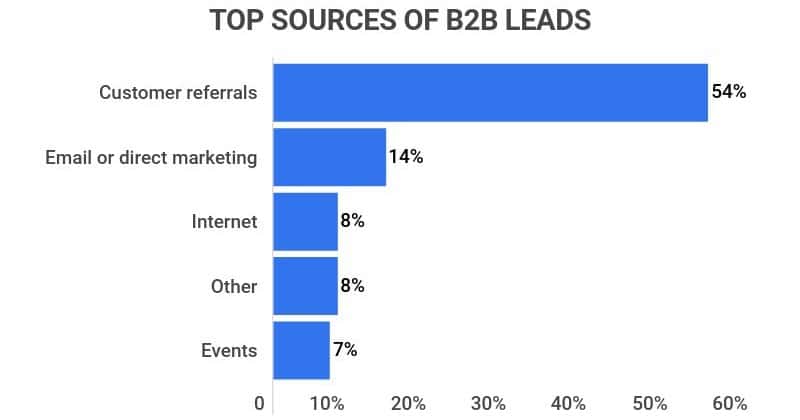
B2B Statistics by Company
B2B companies come and go with varying success rates, and there are many trends these companies follow. Here are some significant B2B company trends, according to our research:
-
B2B companies with 100-500 employees involve an average of 7 people in decision-making.
And in general, each decision-maker will independently gather four or five pieces of research they found themselves. Together, that’s up to 35 pieces of information, meaning that it’s important to B2B companies to provide facts about why their products work.
-
The average B2B sales cycle is between 1-6 months.
For new customers who’ve never done business with said B2B company, 48.5% of them will fall under a sales cycle that’s either 1-3 months or 4-6 months. Especially for newer customers, the sales tend to lean on the longer side, as 28.2% of sales cycles are 4-6 months long.
-
22% of returning B2B customers have a sales cycle that’s under a month.
And another 38.4% will have a sales cycle of 1-3 months. That means returning customers are extremely valuable in that they save time and costs.
-
76% of B2B companies have used paid LinkedIn ads.
A further 95% use LinkedIn for organic content marketing. As a whole, LinkedIn is by far the most popular social site for B2B companies.
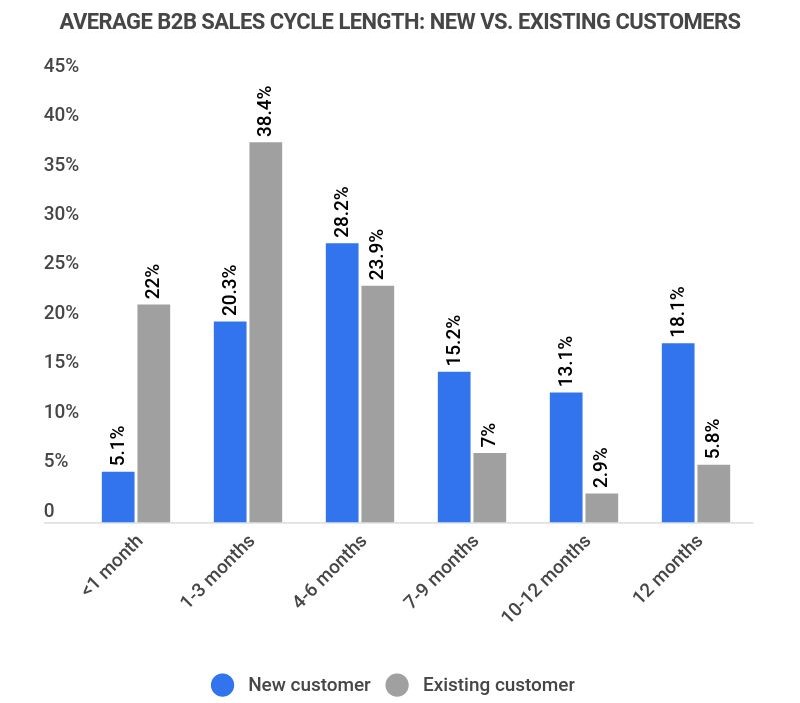
Digital Marketing B2B Statistics
As shown by previous stats, a majority of B2B marketing and discovery is carried out online. Further, digital marketing is only expected to grow within the next decade. Here are some prominent B2B digital marketing stats, according to our research:
-
B2B digital ad spending has grown by 22% in 2021 alone.
Overall, digital ad spending amounted to $8.62 billion in 2021, and it is expected to grow to $14.5 billion in 2024. Luckily, this growth was a significant rebound from the drop to $5.56 billion in 2020.
-
LinkedIn is the #1 social media platform for B2B leads.
That’s because LinkedIn is a massive 277% more effective for lead generation than other social media networks. This is also somewhat unsurprising, given the strong networking and business focus of LinkedIn.
-
The average B2B blog post takes roughly 4 hours to write.
That’s up from 2 hours and 24 minutes in 2014. In part, the increase in time can be attributed to the desire for longer articles, as many blog posts today stretch to at least 2,000 words.
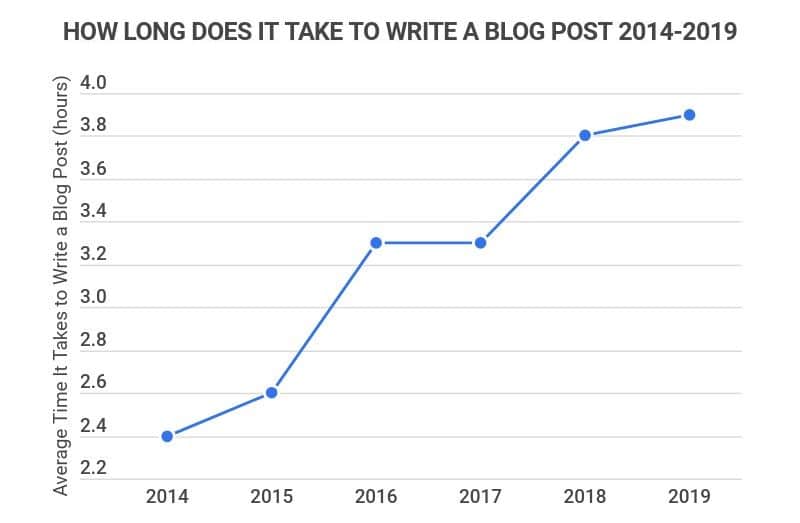
-
38% of B2B brands get outside marketing help.
56% of brands handle their marketing entirely in-house. One common reason for the increase in outsourcing is freelancers, as many B2B brands rely on hiring them for marketing.
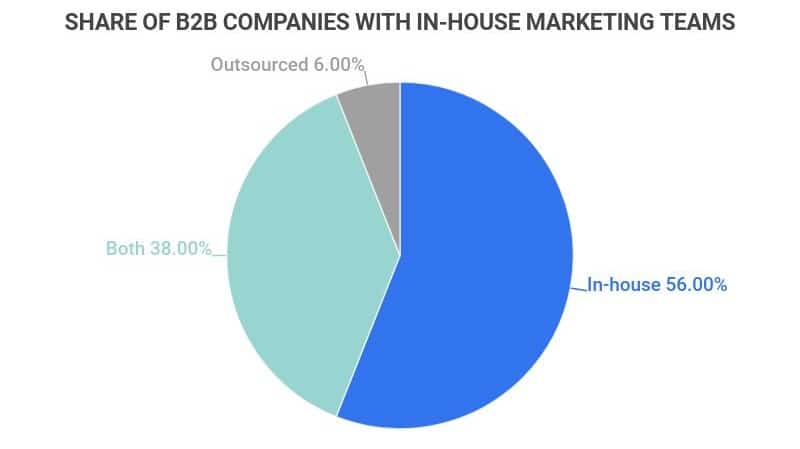
B2B Trends and Predictions
Despite some hiccups due to the COVID-19 Pandemic, B2B businesses are still on track for success and growth going forward. Here are some of the most telling B2B trends and predictions:
-
73% of B2B executives agree that customers expect more personalization than they did a few years ago.
While many B2B companies don’t meet the personalization standards of their customers, focusing on personalization can be a huge benefit. Overall, B2B businesses that focus more on personalization can have up to 25% higher conversion rates and a 15% increase in revenue.
-
Today, at least 40% of B2B businesses focus on CX.
For context, that percentage is up from only 3% back in 2015, which is a massive increase. Further, the importance placed on CX will only increase going forward, as 80% of customers feel as though CX is just as important as the goods/services a company provides.
-
45% of B2B buyers want features like a personalized content portal.
They cite this because personalized content portals will help them find the right information quickly. This was the most important feature to buyers, but other valuable features include an ROI calculator (44%), augmented reality (38%), and video chats (33%).
-
74% of B2B buyers are at least somewhat likely to buy based on CX alone.
Meaning that CX can affect a customer’s decision more than price or offered solutions in many cases. In fact, another 74% of buyers will pay more for great CX and have a 30% higher retention rate.
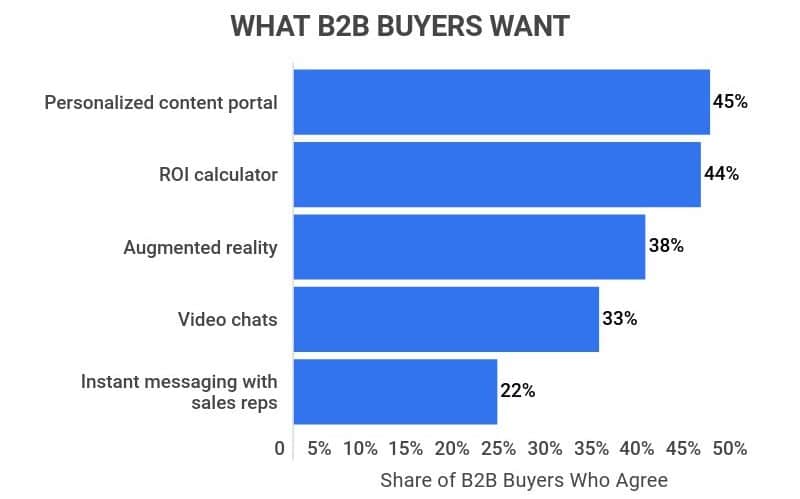
B2B Statistics FAQ
-
How many people are in B2B sales?
At least 2-3 million people are in B2B sales. That’s roughly 16% of the 15.8 million U.S. employees who work in sales. Most of these individuals work online, meeting clients through chat boxes or video calls.
-
How much is the B2B market worth?
The B2B e-commerce market is worth roughly $14.9 trillion, while B2B revenue is worth $6.7 trillion. Despite a dip in 2020, the market is expected to experience a healthy CAGR of 14.1% between 2021-2027.
-
What are the biggest B2B industries?
The five biggest B2B industries are Virtual and Augmented Reality (VR/AR), Medical Marijuana, Financial Technology (FinTech), Biotechnology, and Content Marketing. The growth of AR/VR is especially prominent, with an expected CAGR of 31.5% from 2021 to 2026.
-
What percentage of business is B2B?
Approximately 23.6% of business is B2B, by share of sales. Overall, 12.1% of U.S. company sales over the internet are for B2B products and 11.5% are for B2B services.
-
What percentage B2B buyers are millennials?
59% of B2B buyers are millennials, putting them in the majority for this role. As millennials grew up with the emergence of smartphones and social media, B2B sellers are having to adapt to meet the needs of buyers who are more inclined to prefer digital technologies.
In addition, the largest wholesale marketplace in the world is Alibaba. Other large markets include TradeIndia, Global Sources, IndiaMart, Made-In-China, eWorldTrade, and Amazon.
Conclusion
More than ever, B2B companies are relying on digital marketing. In fact, 67% of the buyer’s B2B journey is done digitally. Plus, 83% of B2B marketers now use social media content, with LinkedIn being the most popular site.
Overall, 76% of B2B companies have used paid LinkedIn ads, but this is unsurprising, as LinkedIn is 277% more effective for lead generation than other social media networks.
On top of social media usage, B2B businesses are finding it more and more vital to offer a personalized experience to their customers. Even though this can make marketing difficult, 45% of B2B buyers want features like a personalized content portal. No wonder 73% of B2B executives agree that customers expect more personalization than they did a few years ago.
In general, moving toward digital marketing and personalization strategies will help make many B2B businesses more successful. Doing so will increase the number of emails read and improve overall discoverability.
References
-
HubSpot. “Sales Email vs. Cold Call: When to Use Each According to Data.” Accessed on November 15th, 2021.
-
Leadfeeder. “B2B Video Marketing: 6 Tips to Start Your Strategy.” Accessed on November 15th, 2021.
-
Campaign Monitor. “2019 Year in Review.” Accessed on November 15th, 2021.
-
Whittington Counseling. “5 Statistics About B2B Demand Generation with Social Media.” Accessed on November 15th, 2021.
-
Learnwoo. “B2B Businesses Should Take the Help of Blogs to Drive Sales – A Talk.” Accessed on November 15th, 2021.
-
LinkedIn. “How Sales Can Win Before 57% of the Buyer’s Journey is Over.” Accessed on November 15th, 2021.
-
InkSoft. “Increase Your Profits with Question-Based Selling for Print Shops.” Accessed on November 15th, 2021.
-
RainmakerVT. “82% of B2B decision-makers think salespersons are unprepared.” Accessed on November 15th, 2021.
-
Adoric. “What is a Good Conversion Rate and How to Improve It.” Accessed on November 15th, 2021.
-
VividFish. “55% of B2B buyers search for information on social media.” Accessed on November 15th, 2021.
-
FocusVision. “Reigns Supreme: Content in the B2B Buyer’s Journey.” Accessed on November 15th, 2021.
-
The EnduranceGroup. “Case Study: Get Decision Makers To Your Table.” Accessed on November 15th, 2021.
-
Callbox. “The Five BEST Sources Of B2B Leads Prospects.” Accessed on November 15th, 2021.
-
Internalresults. “B2B Buyers: What Content Do They Respond To Best?” Accessed on November 15th, 2021.
-
LinkedIn. “How to Know if Your Company Needs a B2B Marketing Agency.” Accessed on November 15th, 2021.
-
Conquer. “The Great Sales Shift: How Digital Sellers Are Transforming The Customer Experience.” Accessed on November 16th, 2021.
-
Close. “Sales cycles: An actionable guide to sales cycle management.” Accessed on November 16th, 2021.
-
Digital Third Coast. “LinkedIn Marketing Advertising Statistics.” Accessed on November 16th, 2021.
-
SalesFuel. “B2B Digital Ad Spending to Grow by 22% This Year.” Accessed on November 16th, 2021.
-
ContentPowered. “How Long Should It Take to Write a Blog Post on Average?” Accessed on November 16th, 2021.
-
Statista. “Share of B2B companies who have dedicated in-house marketing teams in the United States in 2020.” Accessed on November 16th, 2021.
-
Reflektion. “Improve the B2B Commerce Experience through AI.” Accessed on November 16th, 2021.
-
Marketing Charts. “B2B CMOs Keep the Focus on CX.” Accessed on November 16th, 2021.
-
Digital Commerce 360. “B2B buyers want more portal access and personal attention.” Accessed on November 16th, 2021.
-
ClickZ. “CX is as important as product or price, says new report.” Accessed on November 16th, 2021.





